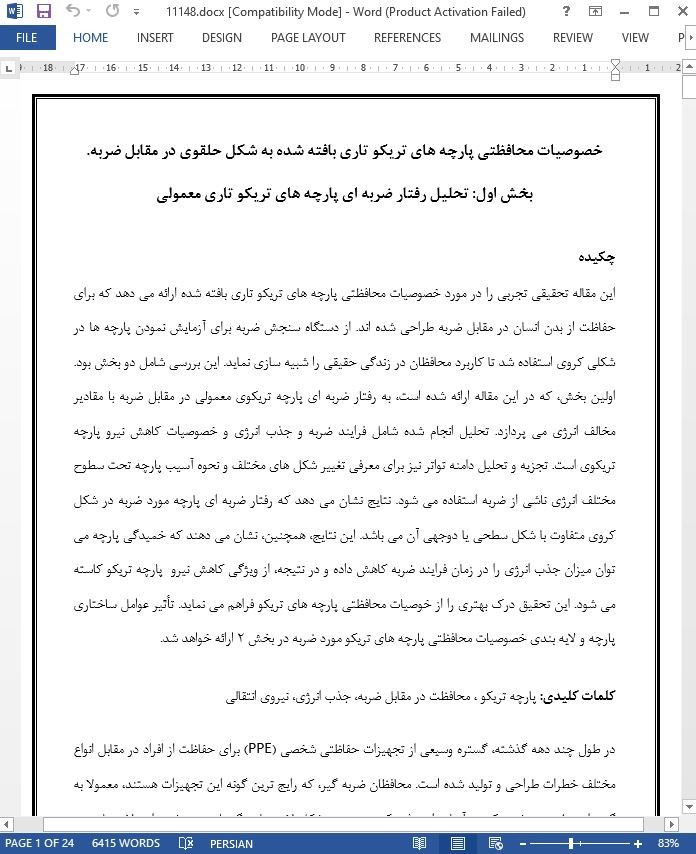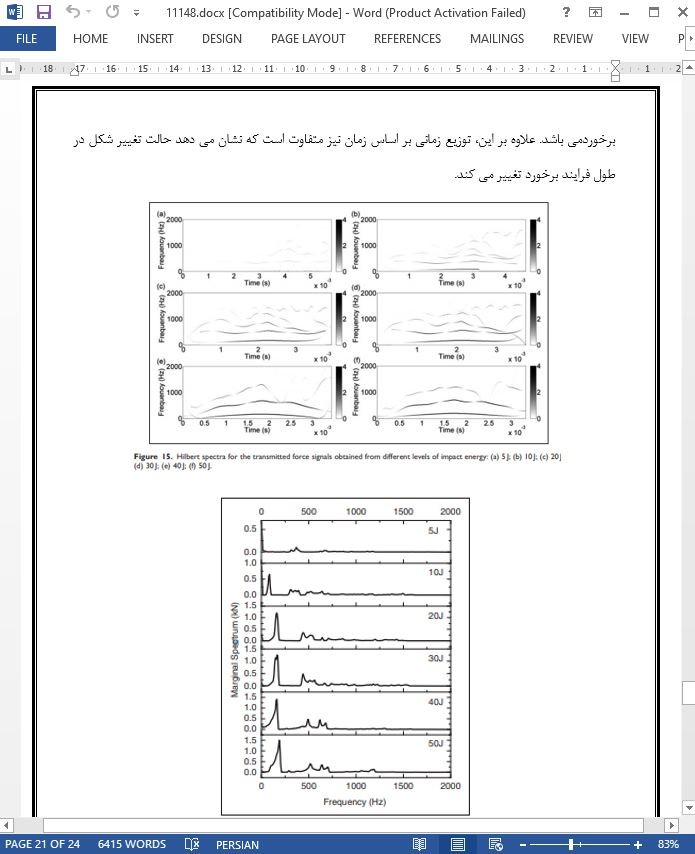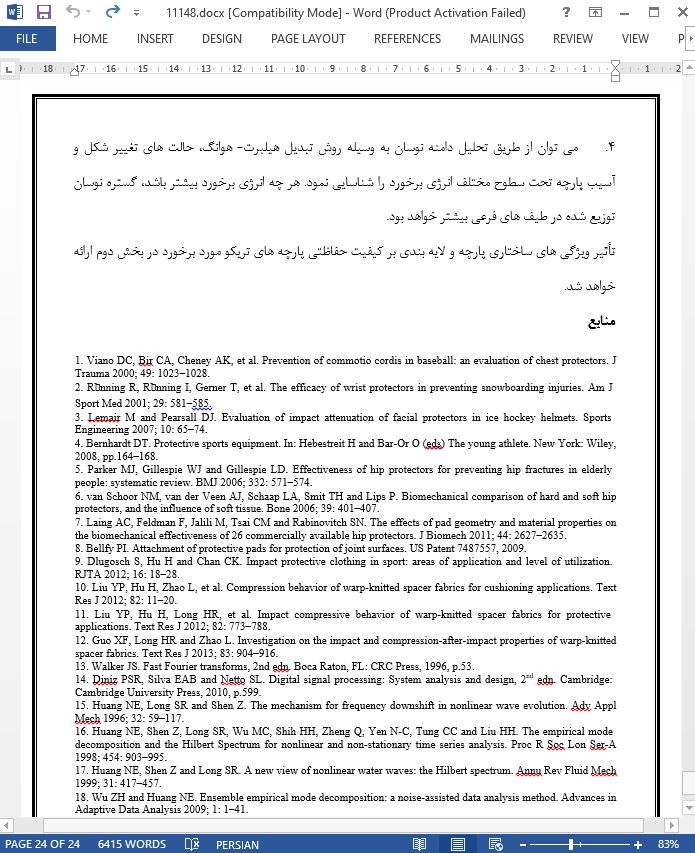
خصوصیات محافظتی پارچه های تریکو تاری بافته شده به شکل حلقوی در مقابل ضربه
چکیده
این مقاله تحقیقی تجربی را در مورد خصوصیات محافظتی پارچه های تریکو تاری بافته شده ارائه می دهد که برای حفاظت از بدن انسان در مقابل ضربه طراحی شده اند. از دستگاه سنجش ضربه برای آزمایش نمودن پارچه ها در شکلی کروی استفاده شد تا کاربرد محافظان در زندگی حقیقی را شبیه سازی نماید. این بررسی شامل دو بخش بود. اولین بخش، که در این مقاله ارائه شده است، به رفتار ضربه ای پارچه تریکوی معمولی در مقابل ضربه با مقادیر مخالف انرژی می پردازد. تحلیل انجام شده شامل فرایند ضربه و جذب انرژی و خصوصیات کاهش نیرو پارچه تریکوی است. تجزیه و تحلیل دامنه تواتر نیز برای معرفی تغییر شکل های مختلف و نحوه آسیب پارچه تحت سطوح مختلف انرژی ناشی از ضربه استفاده می شود. نتایج نشان می دهد که رفتار ضربه ای پارچه مورد ضربه در شکل کروی متفاوت با شکل سطحی یا دوجهی آن می باشد. این نتایج، همچنین، نشان می دهند که خمیدگی پارچه می توان میزان جذب انرژی را در زمان فرایند ضربه کاهش داده و در نتیجه، از ویژگی کاهش نیرو پارچه تریکو کاسته می شود. این تحقیق درک بهتری را از خوصیات محافظتی پارچه های تریکو فراهم می نماید. تأثیر عوامل ساختاری پارچه و لایه بندی خصوصیات محافظتی پارچه های تریکو مورد ضربه در بخش 2 ارائه خواهد شد.
در طول چند دهه گذشته، گستره وسیعی از تجهیزات حفاظتی شخصی (PPE) برای حفاظت از افراد در مقابل انواع مختلف خطرات طراحی و تولید شده است. محافظان ضربه گیر، که رایج ترین گونه این تجهیزات هستند، معمولا به گونه ای تولید می شوند که در آنها مواد جذب کننده نیرو به شکل لایی هایی گنجانده می شود. این لایه ها درون این لباس ها یا تجهیزات حفاظتی، که مخصوصا برای حفاظت از بدن انسان در مقابل ضربه، مشت یا سقوط طراحی شده اند، الحاق یا جا داده می شود. تعدادی از انواع مختلفی از محافظان در برابر ضربه برای حفاظت از قسمت های مختلف بدن در شرایط گوناگون در بازار موجود هستند.
نتیجه گیری
پارچه های تریکو تاری بافته شده معمولی برای حفاظت از بدن انسان در مقابل بافته شده بود، در شکل کروی و در سطوح مختلف انرژی برخورد مورد آزمایش قرار گرفت. مقاومت در برابر ضربه، جذب انرژی و ویژگی های کاهش نیروی آن با در نظر گرفتن نتایج تجربی مورد بررسی قرار گرفت. تحلیل دامنه نوسان به وسیله روش HHT نیز برای تجزیه و تحلیل حالت های مختلف تغییر شکل و آسیب مورد استفاده قرار گرفت. بر اساس نتایج و تحلیل های تجربی، می توان به نتایج زیر رسید:
1. شرایط مرزی واکنش پارچه تریکو در مقابل ضربه را تعیین می کند. مرحله ثبات پارچه تریکو مورد ضربه در شکل کروی به خاطر تغییر منطقه تماس پارچه در طول فرایند برخورد و مراحل مختلف تغییر شکل نخ های تریکو تحت جابجایی مشابه ضربه به روشنی مشاهده نمی شود.
Abstract
This paper presents an experimental study of the protective properties of warp-knitted spacer fabrics developed for protecting the human body on impact. A drop-weight impact tester was used to test the fabrics in a hemispherical form to simulate the use of impact protectors in real life. The study consists of two parts. The first part, presented in the current paper, focuses on the impact behavior of a typical spacer fabric impacted at different levels of energy. The analysis includes the impact process and the energy absorption and force attenuation properties of the spacer fabric. Frequency domain analysis is also used, to identify the different deformation and damage modes of the fabric under various levels of impact energy. The results show that the impact behavior of the fabric under impact in the hemispherical form is different from that in the planar form. The results also indicate that the curvature of the fabric can reduce energy absorption during the impact process and therefore reduce the force attenuation properties of the spacer fabric. This study provides a better understanding of the protective properties of spacer fabrics. The effect of fabric structural parameters and lamination on the protective properties of spacer fabrics under impact will be presented in Part II.
Over the past few decades a wide range of personnel protective equipment (PPE) has been developed to protect wearers from various types of risks or hazards to their health and safety.1–7 Impact protectors, which are the most commonly used PPE, are normally manufactured to include energy-absorbing material in the form of pads.8,9 They are integrated or inserted into protective clothing or equipment specially designed for protecting the human body from impact, blows or falls. A number of different types of impact protectors are on the market for protecting different areas of the body in a variety of circumstances.1–4
Conclusions
A typical warp-knitted spacer fabric developed for human body protection against impact was tested in the hemispherical form at different levels of impact energy. Its impact resistance, energy absorption and force attenuation properties were investigated in the light of the experimental results. The frequency domain analysis with HHT method was also used to analyze its different deformation and damage modes. According to the experimental results and analysis, the following conclusions can be drawn:
1. The boundary condition determines the impact response of the spacer fabric. The plateau stage of the spacer fabric under impact in the hemispherical form is not clearly observed due to the change of the contact area of the fabric during the impact process and different deformation stages of spacer yarns under similar displacement of the striker.
چکیده
جزئیات آزمایش
پارچه تریکو
شیوه آزمایش
نتایج و بحث
تحلیل فرایند ضربه
ویژگی های جذب انرژی و کاهش نیرو
تحلیل دامنه نوسان
نتیجه گیری
Abstract
Experimental details
Spacer fabric
Test method
Results and discussion
Impact process analysis
Energy absorption and force attenuation properties
Frequency domain analysis
Conclusions
- ترجمه فارسی مقاله با فرمت ورد (word) با قابلیت ویرایش، بدون آرم سایت ای ترجمه
- ترجمه فارسی مقاله با فرمت pdf، بدون آرم سایت ای ترجمه



